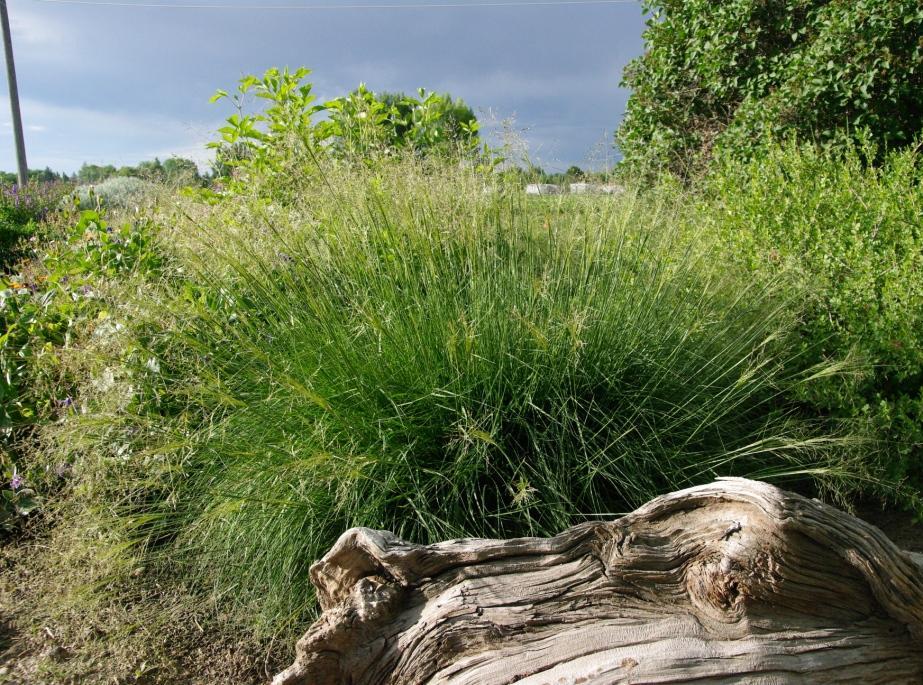Alkali Sacaton in the Landscape

Stephen Love, University of Idaho
Scientfic Name: Sporobolus airoidesCommon Name: Alkali Sacaton
Description: Alkali sacaton is an adaptable, durable, and attractive grass with great potential as an ornamental. Medium-sized in stature, this species provides an extended season of beauty with its long-lasting, airy, pinkish seed heads. The tough, fibrous foliage begins growing in early spring. The leaves are gray-green, narrow, and sharply pointed and although not unusually attractive, contribute to the overall value of the plant. Beginning in early summer, masses of seedheads provide a graceful, lacy, glistening show that lasts well into fall. The seed stalks remain attractive into late fall, but tend to break down under snow loads in winter. Alkali sacaton thrives under either xeric or irrigated conditions, making it valuable in any type of landsca
Native Habitat: Sporobolus airoides is a widespread species, being native to the western Great Plains and all of the Intermountain and Pacific Coast states. It commonly inhabits roadsides, seasonally wet meadows, and alkali flats at elevations ranging from 2,600 to 7,700 feet.
Cultural Requirement
Soil: Tolerates virtually any type of soil, including heavy, saturated clays, and soils with high pH and heavy salt loads.
Moisture Tolerance: Withstands a wide range of moisture conditions, from xeric to excessively wet or heavily irrigated locations.
Sun/Shade/Preference: Prefers full sun.
Transplanting: Easy to transplant with high rates of survival both from pot to pot and from pot to garden. Plants develop at a moderately rapid rate, tolerate pot culture, and maintain acceptable appearance in pots up to 5-gallon size.
Propagation: Simple to propagate from seed. No seed pretreatments are required and seed germinates quickly and at a high percentage. Can be easily moved when mature and is easily propagated from crown divisions.
Maintenance (pruning, fertilization, deadheading, division, irrigation, etc):
Minimal maintenance is required. Cut back to stubs 4 to 6 inches tall in late fall and discard the old foliage. As plants age, they expand in size and may benefit from occasional division. They are not prone to center die-out. Apply occasional supplemental irrigation to produce the maximum number of attractive seedheads. Add a small amount of nitrogen fertilizer if plants decline in vigor.
Insect, disease, or other problems: Alkali sacaton exhibits no significant insect or disease problems.
Landscape Value
Use in the Landscape:
Alkali sacaton is a versatile plant for either xeric or traditional landscapes. The toughness of this species means in can be used to beautify very harsh sites in the landscape. It thrives in heat islands around driveways and sidewalks. It is especially attractive when used to create mass plantings. Provides complementary form in mixed beds or borders. Also an effective and competitive element in naturalized areas or meadows. Suitable for naturalized or formal landscape designs.
Foliage: Leaves form a dense, course mound up to 18 inches tall. The leaves are gray-green, narrow, sharply pointed, and stiffly fibrous. Leaves persist throughout the summer.
Timing: June-October
Fruit: Seedheads are arranged in loosely open panicles. Seeds are numerous within each inflorescence.
Form: Plant form is densely mounded prior to bloom and loosely mounded during bloom.
Texture: Medium
Ultimate Size: Pre-bloom plants are typically 12 to 18 inches tall and up to 2 feet wide. Plants in seed are 24 to 36 inches tall and often over 3 feet wide.
Rate of Growth:
Once through the seedling stage, alkali sacaton plants grow at a rapid rate. Young plants consistently bloom the first year after transplanting to the garden. It takes about 3 years for the plants to exhibit full seedhead density and ornamental value. Development is more rapid during periods of heat.
Suggested Plant Partners:
Alkali sacaton has the aesthetic appeal to serve as a medium-sized specimen plant, but is best used in mass plantings or to complement other plants in mixed beds and borders. It can be planted with species exhibiting a wide range of water needs and bloom colors. Recommended partners include Fallugia paradoxa, Symphoricarpos oreophilus, Eriogonum strictum, Stanleya pinnata, Penstemon strictus, Mirabilis multiflora, Gaillardia aristata, Monarda fistulosa, Aquilegia formosa, and Asclepias tuberosa.
Availability: Occasionally available as potted plants at local or mail-order native plant nurseries. Seed can be purchased from native plant seed suppliers.
Cultivars: None.
References:
Busco, J. and Morin, N.R. 2003. Native Plants for High Elevation Western Gardens. Fulcrum Publishing, Golden, CO
Mee, W., Barnes, J., Kjelgren, R., Sutton, R., Cerny, T. and Johnson, C. 2003. Water Wise: Native Plants for Intermountain Landscapes. Utah State University Press, Logan, UT.
Meyer, S., Kjelgren, K.K., Morrison, D.G. and Varga, W.A. 2009. Landscaping on the New Frontier. Utah State University Press, Logan, UT.

